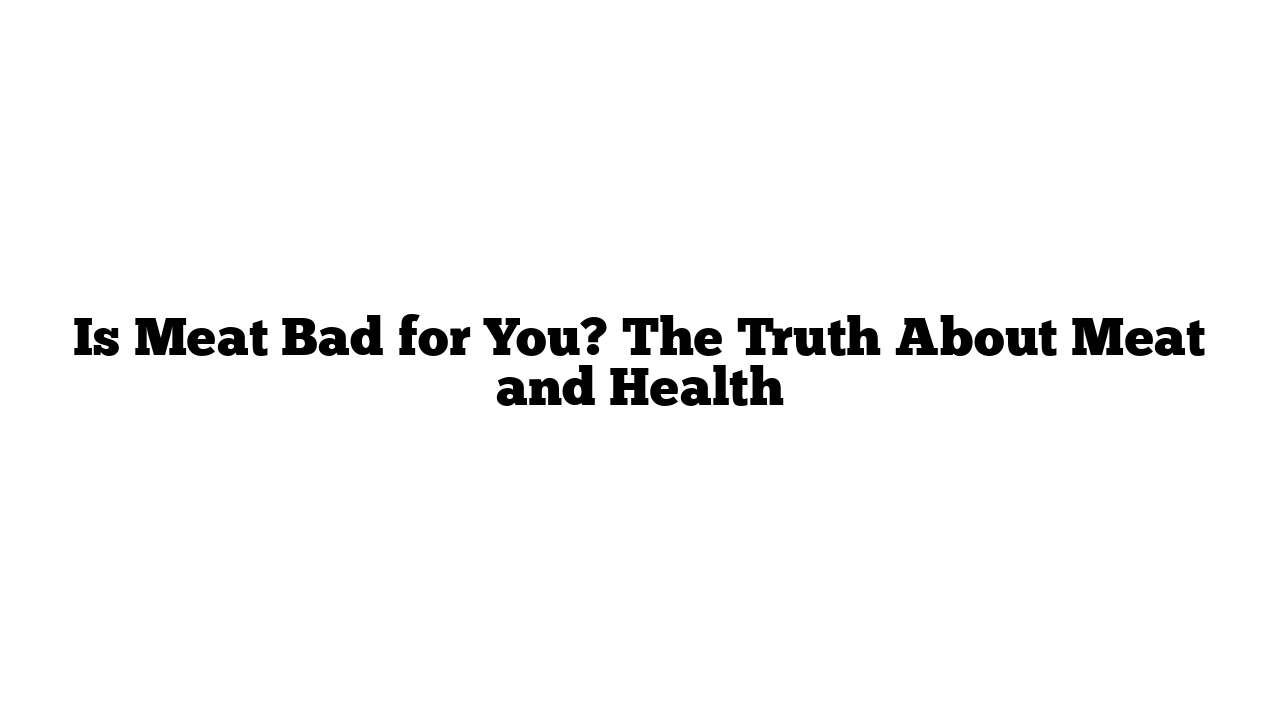When our vegetarian ancestors started eating meat around two million years ago, it was out of necessity, not just because it tastes good. Climate changes had made many plants less available, and meat helped bridge that gap. From the discovery of fire onward, meat became a staple in the human diet.
But in recent years, meat consumption has been linked to health risks like heart disease, certain cancers, and even early death. So, how unhealthy is meat, really? In this Article, we’ll focus exclusively on meat. Dairy products deserve their own discussion.
Why Do We Need to Eat?
Biologically, we eat for three main reasons: to get energy, to provide materials for our cells, and to acquire essential molecules our bodies can’t produce. Energy and most materials come from the three macronutrients: fats, carbohydrates, and proteins. Among these, proteins are crucial for repairing and maintaining our cell structures.
In addition to macronutrients, we need various vitamins and minerals to drive our metabolic processes. Meat provides many of these nutrients. It contains all the essential amino acids our bodies need, along with minerals like iron and zinc. It’s also a rich source of vitamins, including Vitamin B12, which is scarce in plants. However, one essential nutrient is usually missing: Vitamin C, found in most plants, which supports our immune system and helps develop connective tissues. A deficiency can lead to scurvy after just a few months.
The Nutritional Advantages of Meat
One significant advantage of meat is its high bioavailability. Nutrients in meat are broken down and absorbed more quickly than those in plants. For example, spinach has more iron than meat, but it’s absorbed much more slowly and requires more energy to digest.
Communities that rely solely on meat, like the Inuit, have shown remarkable health benefits. Their traditional diet, which includes the whole animal (including organs), provides all the necessary nutrients, including Vitamin C.
So, meat itself isn’t dangerous for us. However, its health effects depend on how it’s prepared and which type of meat we consume.
Types of Meat and Their Health Effects
In the Western world, when we talk about meat, we typically refer to muscle tissue. This meat is nutrient-dense but lacks some essential vitamins.
Fish is often considered the healthiest option. It contains polyunsaturated fatty acids, such as omega-3s, which may reduce the risk of cardiovascular diseases and support anti-inflammatory immune functions. Eating fish regularly is generally safe, although it comes with concerns about overfishing and ocean health.
Chicken is another popular choice, often regarded as having the fewest health risks. However, its saturated fat content may raise cholesterol levels, which has been debated by many scientists.
The conversation gets more complicated with red meats like beef, pork, lamb, and goat. Some studies recommend limiting red meat to just 23 grams per day—about the size of a small steak each week. Large-scale meta-analyses have shown that eating 100 grams of red meat daily can increase the risk of diabetes by 19%, strokes by 11%, and colorectal cancer by 17%.
Understanding the Research
These statistics sound alarming, but it’s essential to consider how these studies are conducted. Most research linking red meat to health risks uses case-control studies, comparing people with diseases to their eating habits. While those who consume more red meat may have higher disease rates, it’s challenging to isolate other lifestyle factors. People who eat less meat often lead healthier lifestyles overall, consuming more fruits and vegetables and being less likely to smoke or drink.
The situation worsens with processed meats like bacon, ham, and sausages. These foods often contain harmful chemicals such as nitrates and nitrites, which can damage DNA in our digestive system and lead to cancer. The WHO reviewed 800 studies over 20 years and concluded that processed meats are strongly linked to an increased risk of colorectal cancer. Each additional 50 grams of processed meat consumed daily raises cancer risk by 18%. In fact, processed meat is now classified alongside plutonium and asbestos regarding its potential to cause cancer.
The Bigger Picture
It also matters how the meat we eat was raised. Many livestock are given antibiotics to prevent diseases, which can contribute to antibiotic resistance. High consumption of both red and processed meat may increase the risk of premature death by up to 29%.
To clarify, meat alone isn’t to blame for health issues. There’s no evidence that the essence of meat has negative effects beyond its high fat content, a point still hotly debated.
Moderation is Key
Many public health agencies recommend limiting meat consumption to 500 grams per week and cutting down on processed meats as much as possible. For most people, this means a significant dietary shift. The average American consumes nearly 1,600 grams of meat weekly, while the average German consumes around 1,100 grams.
To assess your intake, keep a small note of when you eat meat for a week or two. You might be surprised by how much you consume.
In summary, most people Reading this article would benefit from reducing their meat intake. Beyond health concerns, the meat industry is a major contributor to climate change and animal suffering.
————————————————————————–
Overall, in moderation, meat is not unhealthy, and you don’t need to become vegetarian overnight to improve your health and the planet’s health. Your lifestyle choices matter—for yourself and for others.
